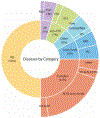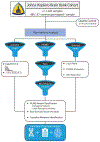Genetic analysis of neurodegenerative diseases in a pathology cohort
- PMID: 30528841
- PMCID: PMC6391207
- DOI: 10.1016/j.neurobiolaging.2018.11.007
Genetic analysis of neurodegenerative diseases in a pathology cohort
Abstract
Molecular genetic research provides unprecedented opportunities to examine genotype-phenotype correlations underlying complex syndromes. To investigate pathogenic mutations and genotype-phenotype relationships in diverse neurodegenerative conditions, we performed a rare variant analysis of damaging mutations in autopsy-confirmed neurodegenerative cases from the Johns Hopkins Brain Resource Center (n = 1243 patients). We used NeuroChip genotyping and C9orf72 hexanucleotide repeat analysis to rapidly screen our cohort for disease-causing mutations. In total, we identified 42 individuals who carried a pathogenic mutation in LRRK2, GBA, APP, PSEN1, MAPT, GRN, C9orf72, SETX, SPAST, or CSF1R, and we provide a comprehensive description of the diverse clinicopathological features of these well-characterized cases. Our study highlights the utility of high-throughput genetic screening arrays to establish a molecular diagnosis in individuals with complex neurodegenerative syndromes, to broaden disease phenotypes and to provide insights into unexpected disease associations.
Keywords: Brain bank; Genotype-phenotype; NeuroChip; Neurodegeneration.
Published by Elsevier Inc.
Figures



References
-
- Blauwendraat C, Faghri F, Pihlstrom L, Geiger JT, Elbaz A, Lesage S, Corvol JC, May P, Nicolas A, Abramzon Y, Murphy NA, Gibbs JR, Ryten M, Ferrari R, Bras J, Guerreiro R, Williams J, Sims R, Lubbe S, Hernandez DG, Mok KY, Robak L, Campbell RH, Rogaeva E, Traynor BJ, Chia R, Chung SJ, International Parkinson’s Disease Genomics, C., Consortium, C.-P., Hardy JA, Brice A, Wood NW, Houlden H, Shulman JM, Morris HR, Gasser T, Kruger R, Heutink P, Sharma M, Simon-Sanchez J, Nalls MA, Singleton AB, Scholz SW, 2017. NeuroChip, an updated version of the NeuroX genotyping platform to rapidly screen for variants associated with neurological diseases. Neurobiol. Aging - PMC - PubMed
Publication types
MeSH terms
Substances
Grants and funding
LinkOut - more resources
Full Text Sources
Medical
Miscellaneous

